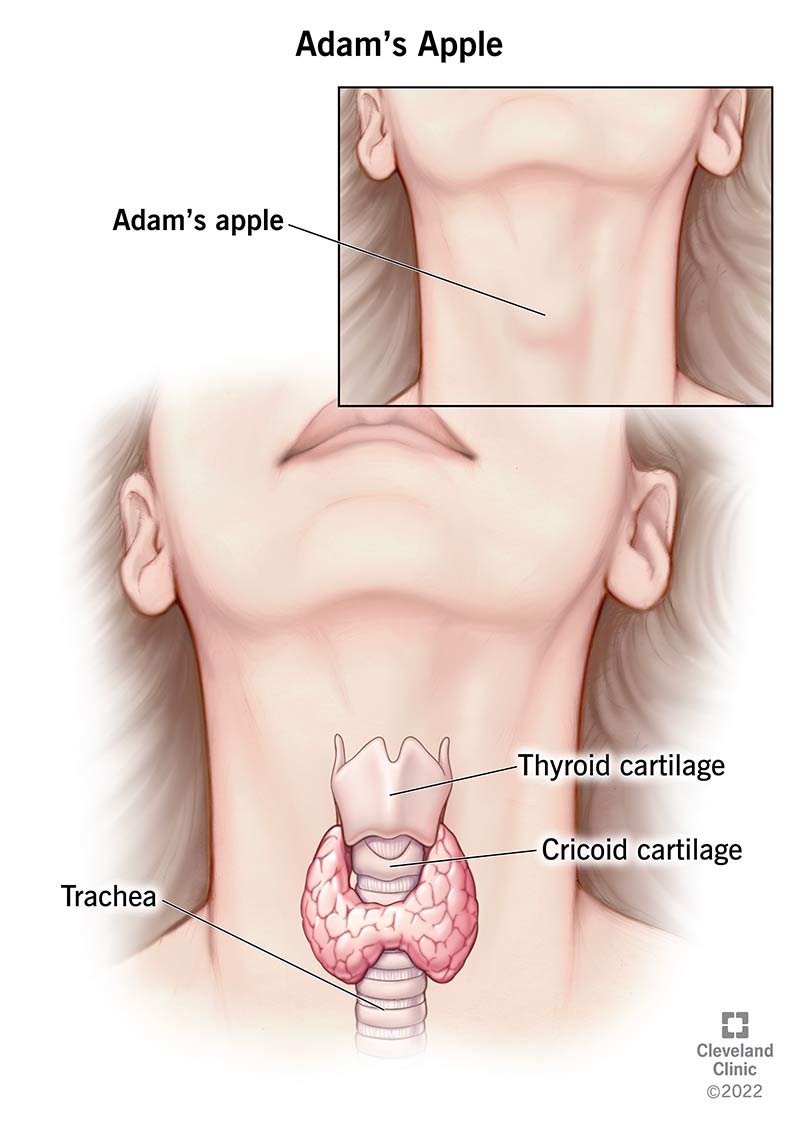The term “Adam’s apple” refers to the bump that’s visible on the front of some people’s throats. It’s made of cartilage and it protects your voice box. Everyone has cartilage in this area that grows larger during puberty. But it’s typically larger in males.
Advertisement
Cleveland Clinic is a non-profit academic medical center. Advertising on our site helps support our mission. We do not endorse non-Cleveland Clinic products or services. Policy

An Adam’s apple is the bump or protrusion on the front of many people’s throats. It’s the cartilage that covers the front of your larynx (voice box). Everyone has this cartilage, but it’s not always visible.
Advertisement
Cleveland Clinic is a non-profit academic medical center. Advertising on our site helps support our mission. We do not endorse non-Cleveland Clinic products or services. Policy
The medical term for Adam’s apple is “laryngeal prominence.”
The term “Adam’s apple” likely comes from the Judeo-Christian tradition. According to the story of Adam and Eve, an apple got stuck in Adam’s throat after he ate the forbidden fruit from the Tree of Knowledge.
Females have cartilage that covers their voice box, just as males do. But during puberty, males usually have more growth in this area.
In short, some people have an Adam’s apple and some don’t. Having or not having an Adam’s apple has no bearing on your health. But some people may choose to pursue cosmetic surgery to make their Adam’s apple smaller or larger, depending on their personal preferences.
The purpose of the Adam’s apple is to protect your voice box from injury. Apart from that, an Adam’s apple has no known function.
Many researchers believe that a larger Adam’s apple plays a role in voice deepening and maturation. But no concrete evidence yet exists.
Your Adam’s apple is at the front of your throat. (Some people have an Adam’s apple, and some don’t.) The visible lump you see consists of cartilage that wraps around your larynx.
Even if you can’t see a bump over your larynx, sometimes you can feel it. Try touching the front of your throat while you hum. When you find the area where the vibrations are the strongest, you’ve found your larynx.
Advertisement
Your Adam’s apple consists of thyroid cartilage — the largest of nine cartilages in your larynx. Other parts of your voice box and trachea (windpipe) consist of other types of cartilage, including cricoid cartilage, epiglottic cartilage and arytenoid cartilage.
From the outside, your Adam’s apple looks like a small, round bump on the front of your throat. Inside your body, the thyroid cartilage that surrounds your Adam’s apple contains two cartilage plates. These two plates join at the front of your throat, forming a V-shaped notch.
The size of an Adam’s apple varies from person to person. Often, males have larger Adam’s apples. But this isn’t always the case.
It’s possible to develop pain in your Adam’s apple. This can result from:
There are also conditions that may cause swelling in your larynx. This can result in an Adam’s apple that’s bigger than usual. Conditions that can affect your larynx in this way include:
A large Adam’s apple doesn’t mean you have a medical condition. But if you notice that your Adam’s apple is sore or swollen, it could indicate an underlying issue. Signs to watch for may include:
If you develop symptoms — especially ones that don’t go away — schedule an appointment with a healthcare provider. They can find out what’s causing your symptoms and recommend appropriate treatment.
Some people choose surgery because they want to change the size or shape of their Adam’s apple. Surgeons perform these procedures by adding or removing cartilage in the area.
Everyone has cartilage that protects their larynx. When this lump of cartilage is visible on the outside of the throat, it’s an Adam’s apple. An Adam’s apple has no impact on your health. It’s simply a cosmetic feature that some people may choose to change through surgery.
Advertisement
Cleveland Clinic’s primary care providers offer lifelong medical care. From sinus infections and high blood pressure to preventive screening, we’re here for you.

Last reviewed on 01/29/2023.
Learn more about the Health Library and our editorial process.